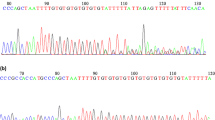Abstract
This study aimed to analyze the distribution of single-nucleotide polymorphisms (SNPs) of testis-expressed 15 (TEX15) gene in the Chinese Han infertile men and fertile men. This case–control study comprised 309 infertile men with nonobstructive azoospermia (NOA, n = 199) or severe oligozoospermia (SO, n = 110) and 377 fertile controls. Six SNPs were genotyped by Sequenom iplex technology. The results showed that the variants rs323346 and rs323347 contributed to the increasing risk of SO (P = .041, odds ratio [OR] = 1.635, 95% confidence interval [CI] = 1.018–2.628 and P = .046, OR = 1.616, 95% CI = 1.006-2.597). The haplotype AT of the SNPs rs323347 and rs323346 could reduce risk in the patients with SO (P = .040, OR = 0.616, and 95% CI = 0.383–0.990). The haplotype GC of the variants rs323347 and rs323346 conferred a significantly increased risk of SO (P = .040, OR = 1.624, 95% CI = 1.010–2.610). Thus, the polymorphisms rs323346 and rs323347 of the TEX15 gene could be considered the genetic risk factors for spermatogenic failure in the Chinese Han population.
Similar content being viewed by others
References
Hirsh A. Male subfertility. BMJ. 2003;327(7416):669–672.
Brugh VM 3rd, Lipshultz LI. Male factor infertility: evaluation and management. Med Clin North Am. 2004;88(2):367–385.
Vogt PH. Molecular genetics of human male infertility: from genes to new therapeutic perspectives. Curr Pharm Des. 2004; 10(5):471–500.
Tuttelmann F, Rajpert-De Meyts E, Nieschlag E, Simoni M. Gene polymorphisms and male infertility—a meta-analysis and literature review. Reprod Biomed Online. 2007;15(6):643–658.
Wang PJ, McCarrey JR, Yang F, Page DC. An abundance of X-linked genes expressed in spermatogonia. Nat Genet. 2001; 27(4):422–426.
Loriot A, Boon T, De Smet C. Five new human cancer-germline genes identified among 12 genes expressed in spermatogonia. Int J Cancer. 2003;105(3):371–376.
Wang PJ, Page DC, McCarrey JR. Differential expression of sex-linked and autosomal germ-cell-specific genes during spermatogenesis in the mouse. Hum Mol Genet. 2005;14(19): 2911–2918.
Yang F, Eckardt S, Leu NA, McLaughlin KJ, Wang PJ. Mouse TEX15 is essential for DNA double-strand break repair and chromosomal synapsis during male meiosis. J Cell Biol. 2008;180(4): 673–679.
Aston KI, Krausz C, Laface I, Ruiz-Castane E, Carrell DT. Evaluation of 172 candidate polymorphisms for association with oligozoospermia or azoospermia in a large cohort of men of European descent. Hum Reprod. 2010;25(6): 1383–1397.
Plaseski T, Noveski P, Popeska Z, Efremov GD, Plaseska-Karanfilska D. Association study of single nucleotide polymorphisms in FASLG, JMJDIA, LOC203413, TEX15, BRDT, OR2W3, INSR and TAS2R38 genes with male infertility. J Androl. 2011.
Wu B, Lu NX, Xia YK, et al. A frequent Y chromosome b2/b3 subdeletion shows strong association with male infertility in Han-Chinese population. Hum Reprod. 2007;22(4): 1107–1113.
Lu C, Zhang J, Li Y, et al. The b2/b3 subdeletion shows higher risk of spermatogenic failure and higher frequency of complete AZFc deletion than the gr/gr subdeletion in a Chinese population. Hum Mol Genet. 2009;18(6):1122–1130.
Cooper TG, Noonan E, von Eckardstein S, et al. World Health Organization reference values for human semen characteristics. Hum Reprod Update. 2010;16(3):231–245.
Shi YY, He L. SHEsis, a powerful software platform for analyses of linkage disequilibrium, haplotype construction, and genetic association at polymorphism loci. Cell Res. 2005;15(2):97–98.
Dupont WD, Plummer WD Jr. Power and sample size calculations for studies involving linear regression. Control Clin Trials. 1998;19(6):589–601.
Matzuk MM, Lamb DJ. The biology of infertility: research advances and clinical challenges. Nat Med. 2008;14(11):1197–1213.
Toffoli G, De Mattia E. Pharmacogenetic relevance of MTHFR polymorphisms. Pharmacogenomics. 2008;9(9):1195–1206.
Manolio TA, Collins FS, Cox NJ, et al. Finding the missing heritability of complex diseases. Nature. 2009;461(7265):747–753.
Wacholder S, Chanock S, Garcia-Closas M, El Ghormli L, Rothman N. Assessing the probability that a positive report is false: an approach for molecular epidemiology studies. J Natl Cancer Inst. 2004;96(6):434–442.
Author information
Authors and Affiliations
Corresponding authors
Rights and permissions
About this article
Cite this article
Ruan, J., He, XJ., Du, WD. et al. Genetic Variants in TEX15 Gene Conferred Susceptibility to Spermatogenic Failure in the Chinese Han Population. Reprod. Sci. 19, 1190–1196 (2012). https://doi.org/10.1177/1933719112446076
Published:
Issue Date:
DOI: https://doi.org/10.1177/1933719112446076




